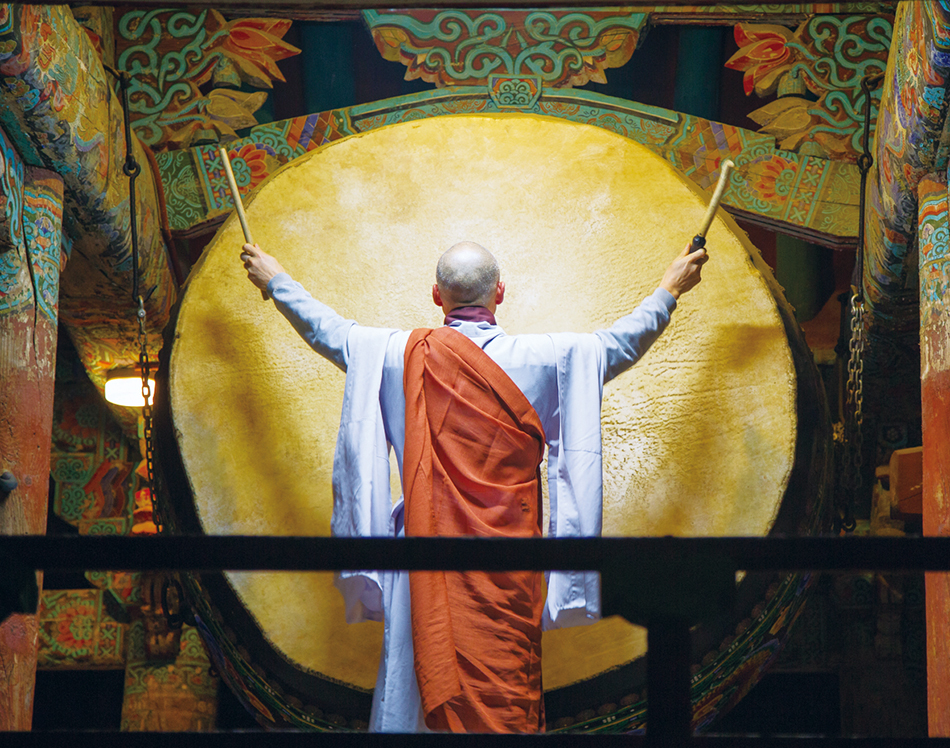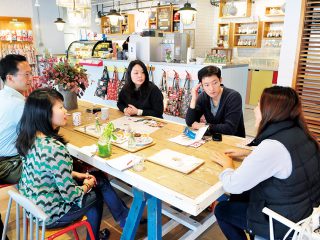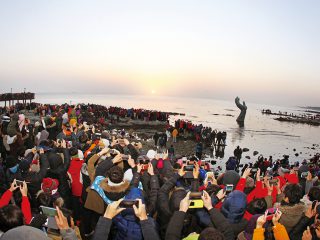[box_light]Beomeosa Templestay 범어사 템플스테이
A Busan hideaway well within the city limits[/box_light]
Written and photographed by Jason Teale
When you want to get away from the hustle and bustle of city life in Korea, it’s natural to start thinking about heading to the mountains and spending some quality time in nature. But with the popularity of “glamping” campsites, many country roads are now almost as busy as the city. Fortunately, there are still a few places where you can find peace and quiet on the weekend, with one of the best options being the Templestay programs that can be found in a variety of communities across the country. The visits, which can occur over the course of an afternoon or even overnight, offer visitors a chance to stay at the temple and learn more about Buddhism in Korea and monastic life in general. Regardless of the length of their visit, participants are immersed in the rituals of temple culture and surrounded by the peacefulness of nature.
At the base of Mt. Geumjeongsan
Beomeosa Temple sits just on the edge of Busan at the foot of Mt. Geumjeongsan, but walking around the temple, you would hardly think that you were still near the city, much less in it. The surrounding mountains and trees seem to block the bustle of the nearby metropolis, allowing for a peaceful experience without having to travel too far.
The temple was first built around the year 678 and has been repaired and rebuilt throughout the ages. It contains not one but three national treasures and enough serenity to make your head spin. Getting the chance to stay overnight surrounded by this much beauty is certainly not an opportunity to be missed.
Beomeosa’s Templestay program is extremely rewarding for those seeking an interesting cultural experience and don’t mind waking up early. The Templestay program has a few different variations, but between the trekking and dado (the tea ceremony) there is something to enlighten and relax almost anyone.
Getting comfortable
The regular Beomeosa Templestay program begins with everyone changing into comfortable, loose-fitting clothing and learning about temple etiquette, an exercise that mainly serves to get you into the temple mind-set. After chatting with the head monk, you are then taken on a tour of the temple.
Even for someone who has spent a lot of time exploring Buddhist worship spaces, there will always be something new to learn. Having every detail of the temple explained by the head monk is not only interesting but you get a deeper understanding of the meaning behind the different components. After the tour, visitors sit down for a meal with the head monk.
Beomeosa’s program has a more updated and comfortable approach to mealtime. Like most temples, however, you typically sit on the floor while a monk leads the group. The meal is served in a similar manner to a school cafeteria and consists of basic Korean food – but all vegetarian. Even the kimchi is made without using any fish products. For me, the most interesting part of this particular meal was the inclusion of vegetarian sausages, which were actually quite delicious. Like most Templestay programs, you are expected to clean your own tray and cutlery.
During the breaks, groups are allowed to wander around the temple. In the evening, the main walkway leading up to the Daeungjeon (main hall) is covered in lanterns – a beautiful sight that’s made even better without so many other people around. Each night, shortly after 6 PM, the monks begin their drumming, blanketing the entire grounds with an intense rhythm and breaking the silence that usually falls on the temple once all of the tourists have left.
Once the drumming stops, you are led up to the Daeungjeon with the monks for a payer ceremony, known as yebul. Prepare yourself: The monks’ chanting will create a fairly surreal experience. This hall is one of the older buildings in Beomeosa, and the interior artwork is especially beautiful.
Following the ceremony it is time to string some prayer beads. The act of sliding beads over string may seem simple enough, but here you stand up and bow with each bead. The guide mentioned that you “do not have to pray to Buddha. You can think about your family, the people you love or anything,” reinforcing the fact that the program is meant to help people experience temple life, not a clever way to attract new members.
The evening ends early and visitors go to bed preparing for an early rise. The final day of the program is a little more active, but like all parts of the program, consideration has been put into each visitor’s physical condition, so activities are not too rigorous.
Luxurious, but not lax
The facilities at Beomeosa are designed in Korean traditional style, meaning that they are comfortable but not luxurious. The best advice that I can give is to really “experience” everything. Temple life is simple but at times not that easy. Enjoy the peace and the beauty of a weekend away from the speed and stress of city life in Korea and your mind and body will thank you.
The Beomeosa Templestay program runs regularly on weekends throughout the year, and you can check their website for dates and more information. The basic program consists of a temple tour, a tea ceremony, chatting with the monks, drumming, chanting and prayer bead stringing. Different programs include hiking, rice cake making and meditation.
The cost of the programs is KRW 70,000 for adults and 60,000 for teenagers. Children under 13 attend for free. All reservations can be made online.
To get to Beomeosa Temple, you can take the subway to Beomeosa Station (Busan Subway Line 1), head to the Beomeosa bus stop (use Exit 7 and walk about 5 minutes) and take bus No. 90. Taxis might be a better option if you have heavy baggage.
How to reserve your stay
FYI> To reserve your special stay at Beomeosa Temple, visit their website at www.beomeosa.co.kr. Click “English” and then click “Sign Up,” and you should see an application where you can enter your desired dates of stay and other essential information.







